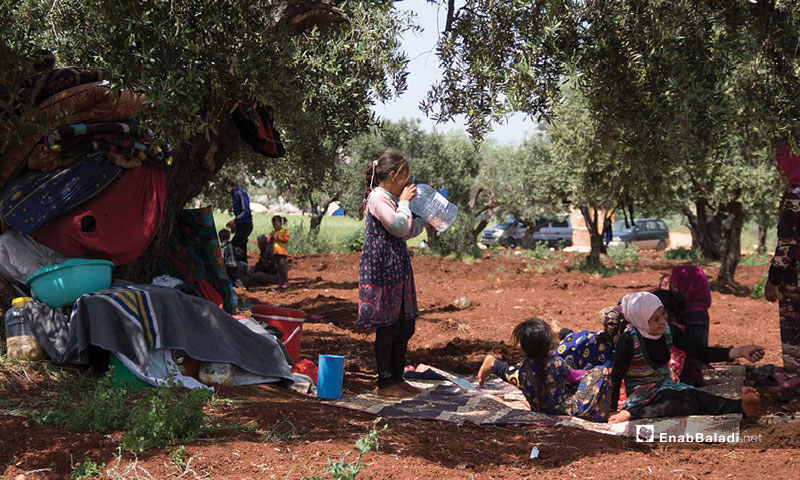



While winter approaches, the housing crisis of the internally displaced persons (IDPs) in the south of Idlib-based ‘buffer zone’ is only worsening despite the initiatives the area’s organizations are launching as an emergency response to the ceaseless displacement of civilians which started about six months ago.
A number of IDPs have started renting houses along the Syrian-Turkish border strip, given that the camps there have run out of the capacity at accommodation; numerous others, who are unable to afford rents, however, were coerced into taking refuge in agricultural lands and olive groves, which they are soon to lose as well, for many of them have been notified of the necessity to leave by the Salvation Government based on the complaints filed by these lands’ owners.
In control of the area administratively, the Salvation Government formed a committee of its ministries to start readying a land, equipping it for construction as to mitigate the effects of the displacement influx, where the number of IDPs has risen to 948,000 since the beginning of the offensive, launched by the Syrian regime and Russia, against Idlib province and rural Hama from February 2 up to August 26, according to the statistics of the Syria Response Coordination Group (SRCG).
The land will be prepared for construction to accommodate up to 18 thousand displaced families, within the frame of a study assessing the plan to involve several government-owned lands as a space for housing projects, Khalid al-Omar, Director of Camps Affairs under the Salvation Government, said.
The committee has already started carrying out its tasks, al-Omar said, pointing out that each family will be allocated 70 square meters designated for the construction of a residence. Applications to land allocations will be evaluated according to age through the Salvation Government-affiliated local councils before they are ratified by the Service Department of the council and are transferred to the concerned committee, where batches of land are to be sorted according to region.
Al-Omar stressed that only concrete buildings are to be granted a construction license.
Khalid al-Omar, Director of the Camps Affairs Directorate of the Salvation Government, said that the lands are of two sorts: The first allows the persons granted a license to build concrete residents with non-concrete ceilings; the second will be designated for the construction of fully equipped houses. The allocation process is to consider the financial capacity of each family.
The Salvation Government has undertaken to secure infrastructure, such as establishing sanitation system, levelling of land, installing water supply lines and drawing water, in addition to providing the camps with food baskets.
The project is implemented in several stages, the first of which covers four thousand families, with a leasing contract between the families and the Salvation Government. The IDPs are to stay there as long as they are incapable of returning to their homes. However, when repatriation becomes possible, the house owner has the right to sell it at the cost of construction whereas the land remains public property.
Nevertheless, it is very difficult to implement the ‘Salvation’ solution, given the deteriorating financial condition of the IDPs and the project’s timing, for the region is “totally unable to make an urgent response to IDPs’ [crisis],” according to the SRCG’s statement on 26 August.
The IDPs, notified of the necessity to evacuate, have denied the Government’s request to move to camps which it set up with the concerned organizations, stressing that they had tried more than one way to obtain housing or a place to erect their tents but to no avail.
Ahmad Nasser Mohammed, a displaced resident near Atmeh area, north of Idlib, complained to Enab Baladi, “Where are those camps? And what have they done for us?”
“We tried to get land so that we could set up our tent, but we have only left the shadow of a tree to make into a shelter.”
The number of camps in northern Syria rose to 600, according to the Salvation Government’s figures. Further, the organizations and the authorities that administer the area are facing the challenge of securing places for the displaced or establishing new camps on public land, according to a UN statement on 23 August.
if you think the article contain wrong information or you have additional details Send Correction